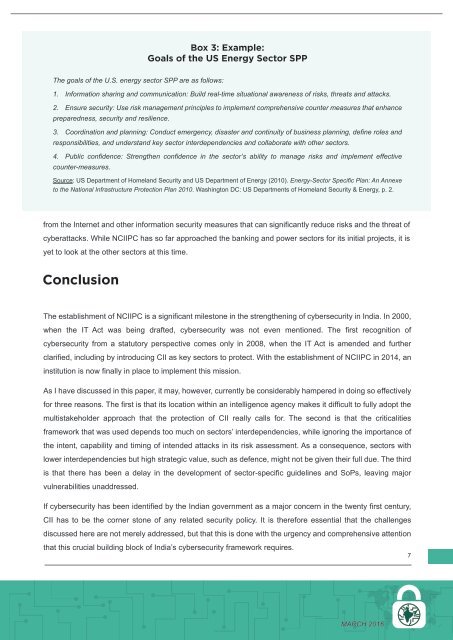INFORMATION INFRASTRUCTURE
Saikat-Datta-Internet-Democracy-Project-Defending-Indias-CII
Saikat-Datta-Internet-Democracy-Project-Defending-Indias-CII
Create successful ePaper yourself
Turn your PDF publications into a flip-book with our unique Google optimized e-Paper software.
Box 3: Example:<br />
Goals of the US Energy Sector SPP<br />
The goals of the U.S. energy sector SPP are as follows:<br />
1. Information sharing and communication: Build real-time situational awareness of risks, threats and attacks.<br />
2. Ensure security: Use risk management principles to implement comprehensive counter measures that enhance<br />
preparedness, security and resilience.<br />
3. Coordination and planning: Conduct emergency, disaster and continuity of business planning, define roles and<br />
responsibilities, and understand key sector interdependencies and collaborate with other sectors.<br />
4. Public confidence: Strengthen confidence in the sector’s ability to manage risks and implement effective<br />
counter-measures.<br />
Source: US Department of Homeland Security and US Department of Energy (2010). Energy-Sector Specific Plan: An Annexe<br />
to the National Infrastructure Protection Plan 2010. Washington DC: US Departments of Homeland Security & Energy, p. 2.<br />
from the Internet and other information security measures that can significantly reduce risks and the threat of<br />
cyberattacks. While NCIIPC has so far approached the banking and power sectors for its initial projects, it is<br />
yet to look at the other sectors at this time.<br />
Conclusion<br />
The establishment of NCIIPC is a significant milestone in the strengthening of cybersecurity in India. In 2000,<br />
when the IT Act was being drafted, cybersecurity was not even mentioned. The first recognition of<br />
cybersecurity from a statutory perspective comes only in 2008, when the IT Act is amended and further<br />
clarified, including by introducing CII as key sectors to protect. With the establishment of NCIIPC in 2014, an<br />
institution is now finally in place to implement this mission.<br />
As I have discussed in this paper, it may, however, currently be considerably hampered in doing so effectively<br />
for three reasons. The first is that its location within an intelligence agency makes it difficult to fully adopt the<br />
multistakeholder approach that the protection of CII really calls for. The second is that the criticalities<br />
framework that was used depends too much on sectors’ interdependencies, while ignoring the importance of<br />
the intent, capability and timing of intended attacks in its risk assessment. As a consequence, sectors with<br />
lower interdependencies but high strategic value, such as defence, might not be given their full due. The third<br />
is that there has been a delay in the development of sector-specific guidelines and SoPs, leaving major<br />
vulnerabilities unaddressed.<br />
If cybersecurity has been identified by the Indian government as a major concern in the twenty first century,<br />
CII has to be the corner stone of any related security policy. It is therefore essential that the challenges<br />
discussed here are not merely addressed, but that this is done with the urgency and comprehensive attention<br />
that this crucial building block of India’s cybersecurity framework requires.<br />
7<br />
MARCH 2016


